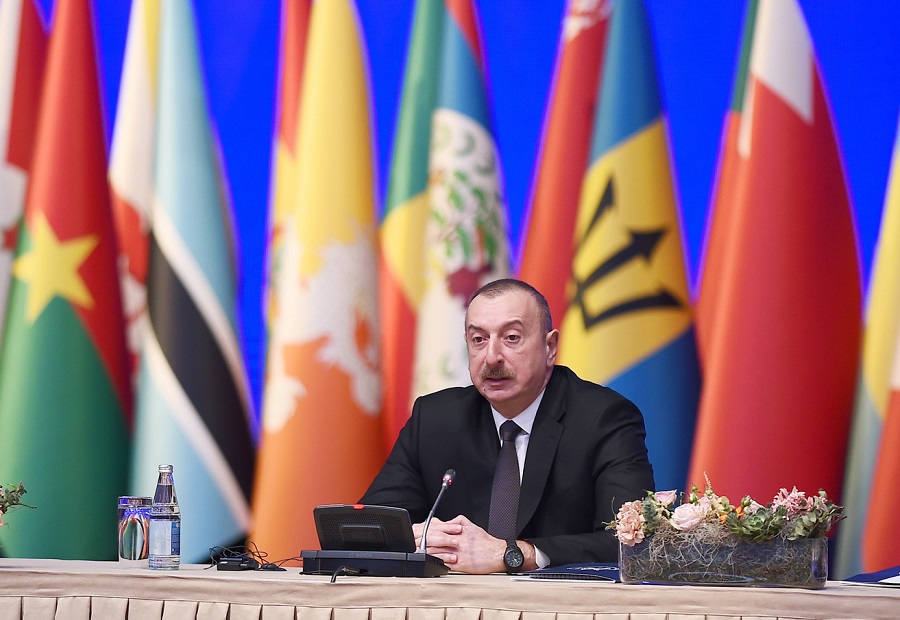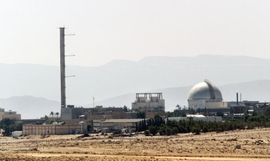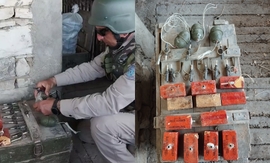One of the South Caucasus’ longest-running conflicts came into the spotlight last week, as high-ranking officials from more than 100 countries gathered together in Baku to attend the 18th Ministerial Meeting of the Non-Aligned Movement – an organization that advocates for international cooperation and multilateralism.
With a more than 25-year-long history, the Armenian-Azerbaijani Nagorno-Karabakh conflict remains the central issue that has been threatening regional peace and stability, according to Azerbaijan’s President Ilham Aliyev.
“The occupation of the Azerbaijani territories must be stopped, and only after that the peace can be established in the region,” the head of the South Caucasus’ largest country said on Thursday while addressing the meeting.
Armenia and Azerbaijan have been at odds since the late 1980s, when Yerevan launched an ethnic cleansing campaign against Azerbaijanis living in Armenia. Following the fall of the Soviet Union in 1991, Armenia launched a military campaign against Azerbaijan, which lasted from 1992 to 1994 and spanned Azerbaijan’s southwestern region of Nagorno-Karabakh and seven surrounding districts.
Over three years, the war claimed the lives of over 20,000 Azerbaijanis, while nearly one million Azerbaijanis were internally displaced and 4,000 went missing. The full-scale war came to a stop in 1994, thanks to a ceasefire, but Azerbaijan’s Nagorno-Karabakh region and seven surrounding districts are still occupied by Armenia.
In 1993, shortly before the war was suspended, the United Nation’s Security Council tabled four resolutions – all demanding the full withdrawal of Armenian troops from Azerbaijan. But Yerevan still ignores those demands.
“There is no mechanism for implementing these resolutions,” President Aliyev said during the Thursday’s meeting.
“If sanctions were imposed against Armenia at the very beginning of the conflict, I think, it [the conflict] would have been settled long ago,” he added.
Despite the war coming to a stop in 1994 after the signing of the Bishkek Protocol in Kyrgyzstan, violations on the frontline are not uncommon. After a series of skirmishes between Armenia and Azerbaijan that took place in 2010, 2012, and 2014, the region has underwent another flare-up in April 2016, following Armenian shelling of Azerbaijani villages.
Those more recent clashes, which were later dubbed the April War, or Four Day War, spanned the line of contact separating the troops of Armenia and Azerbaijan and proved to be the most bloody since 1994. Starting on April 1, 2016, the hostilities continued until April 5, when both sides announced a ceasefire.
As a result of the Four Day War, Azerbaijan retook two strategic hills, a village, and a total of about 2,000 hectares (approximately 5,000 acres) of its land.
Meanwhile, Armenian armed forces have been violating the ceasefire agreement as they have been firing at the Azerbaijan military and civilians every day since 1994. For example, only throughout the previous month, Armenians violated the ceasefire for more than 4,000 times, according to the data provided by Azerbaijan’s Defense Ministry.
Thomas de Waal, a senior fellow with Carnegie Europe, specializing in Eastern Europe and the Caucasus region believes that if there is fighting, it will be hard to manage.
“A new conflict in the Caucasus could lead to thousands of casualties and economic devastation – without resolving the core issues,” he wrote in his article dubbed “The Threat of a Karabakh Conflict in 2017.”
“A descent into a new conflict in the South Caucasus is the last thing anyone wants – least of all the ordinary Armenians and Azerbaijanis who will be caught in the middle of it.”







 The Mine Action Agency of Azerbaijan (ANAMA) reported on Thursday the discovery of a significant amount of explosives in the Khojavand district of ...
The Mine Action Agency of Azerbaijan (ANAMA) reported on Thursday the discovery of a significant amount of explosives in the Khojavand district of ...
 Iran’s Foreign Minister, Hossein Amir-Abdollahian, has labeled a foiled Israeli drone attack in certain parts of the country as a "failure" for Isr...
Iran’s Foreign Minister, Hossein Amir-Abdollahian, has labeled a foiled Israeli drone attack in certain parts of the country as a "failure" for Isr...
 Iran has refuted reports of alleged damage to Shimon Peres Negev Nuclear Research Centre located southeast of Dimona, Israel, during the recent air...
Iran has refuted reports of alleged damage to Shimon Peres Negev Nuclear Research Centre located southeast of Dimona, Israel, during the recent air...



